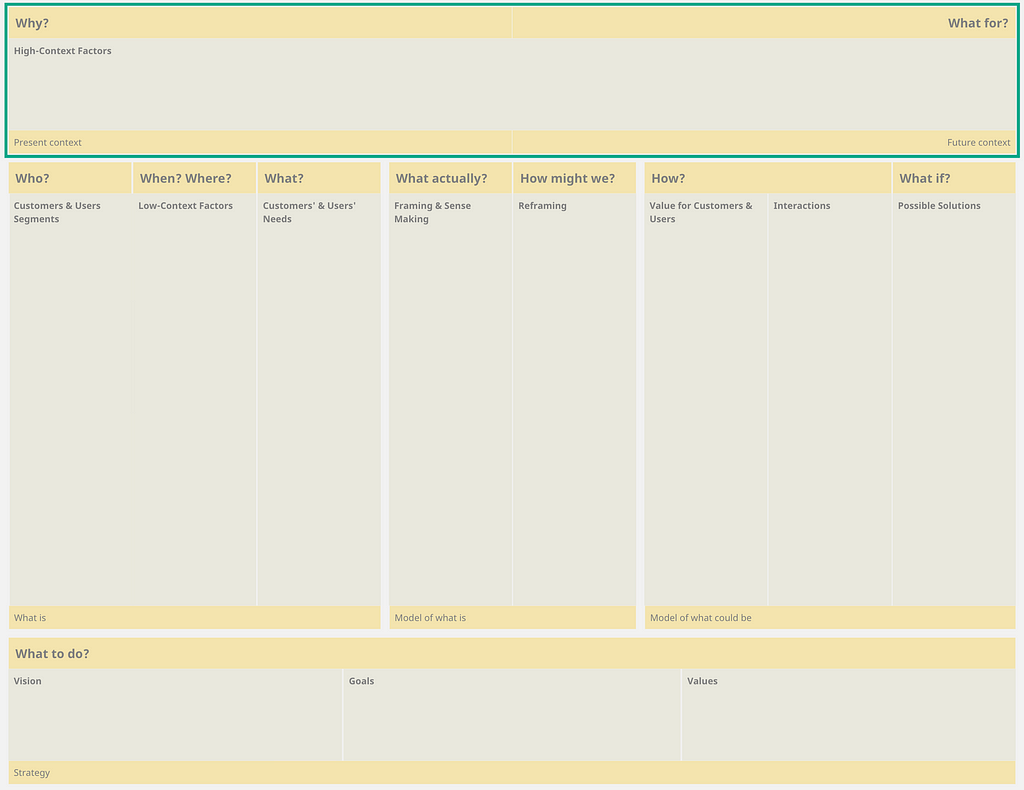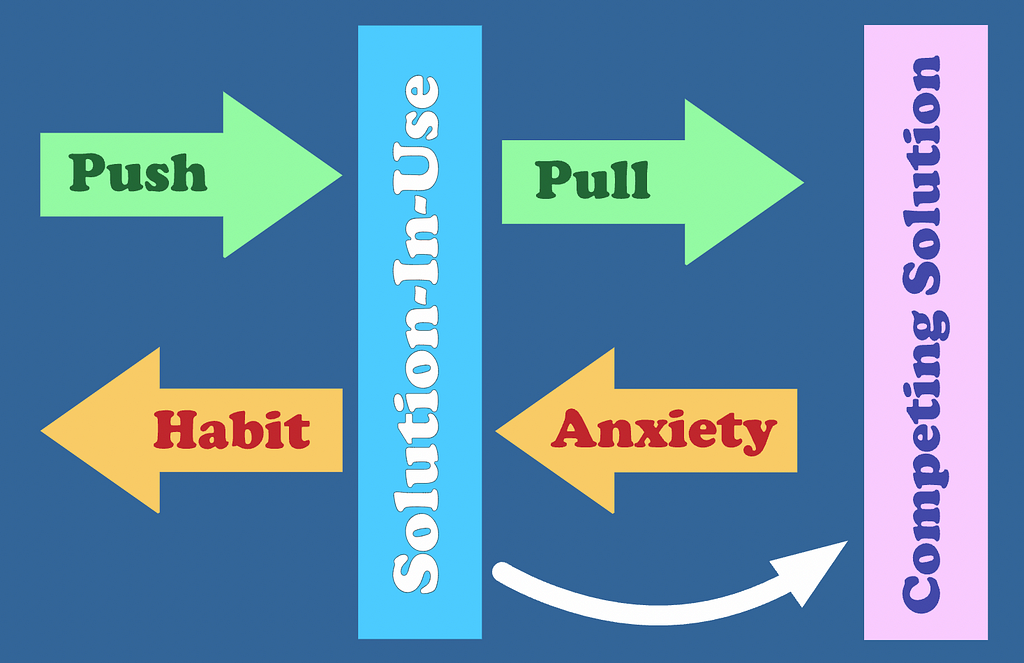Standing up for yourself as a UX person and getting buy-in from senior management.
This text describes in detail the Present context & Future context spot of the Design modeling canvas.

Why? What for?
I reckon that Why & What for? are core questions that don’t let any thing in design come out of the blue. This block describes the present context — underlying reasons or factors behind observable problems, cause behind the symptom. At the same time, this is the place to outline the future context— the desired future state that is supposed to be achieved. The aim here is to see the world in a new way which reflects unique perspective of the stakeholders, their values and believes that drive the change. “People don’t buy what you do; they buy why you do it. And what you do simply proves what you believe.” (Sink)
On the one hand, Why & What for? block describes circumstances that trigger this project and make it actual, covering the question Why on Earth are we going to make it? On the other hand, it articulates what is going to be achieved due to a product/service from business perspective, how it fits into the whole strategy, how it would influence the world — What for are we going to make it? In other words, it is aimed to describe the high-level — generic and impersonal — context of the present state and the desired future (in contrast to low-context, more personal one, which will be described later). This distinction is encouraged by the concept of difference between High-Context and Low-Context cultures, proposed by anthropologist Edward T. Hall.
High-Context Factors imply the widest perspective which encourages a designer to broaden the range of ideas and influences. Reasoning on this high level helps to deconstruct the present situation and express the vision of the desired future state.
To describe high-context factors, the following instruments can be of use:
- the Force Field Model (Lewin), which was adapted in JTBD approach as Forces of Progress (Moesta, Spiek, Fowlkes)
- Vision in Product Design (ViP) framework (Hekkert, van Dijk, Lloyd).
Forces of progress
Answering Why & What for? questions helps to grasp the forces that contribute to the “concrete flux of interpenetrating intensities” (Hulme). These forces appear in the Force Field Model, “that describes any current level of performance or being as a ‘state of equilibrium between the driving forces that encourage upward or forward movement and the restraining forces that discourage it.’ Essentially, this means that a current equilibrium exists because the forces acting for change are balanced by the forces acting against change. The driving forces are (usually) positive, reasonable, logical, conscious and economic. The restraining forces are (usually) negative, emotional, illogical, unconscious and social/psychological.” (Larson)
The Force Field Model is adapted within the JTBD approach and represented as Forces of Progress to analyze customer switching behavior. I suggest to apply it on a high-context level as well.
There appear two driving forces — push and pull — and two restraining forces — habits and anxiety:
- Push is about struggles of the status quo, provoking the movement away from the current situation
- Pull reflects magnetism of a better life, provoking the movement towards desired future
- Habits involve attachments to the present, resisting the movement away from the current situation
- Anxiety associates with uncertainty about adopting new, resisting the movement towards desired future.

While Forces of Progress model provides the means to group high-context factors into four categories (or forces), ViP helps in adding details into each category. Also, each force can be considered from business perspective.
Vision in Product Design
ViP suggests the way to classify factors into certain types: “principles are stable patterns in life, from physical to biological to social and psychological (people are driven by curiosity, for example); they can be laws of nature and fundamental human concerns or patterns of behaviour. The other types of context factor that you will come across are states, things that are relatively constant, the conflict between Palestine and Israel for example, developments, by which we mean things that are changing over time, so for example global warming, and their accompanying trends in people’s behavior as a result of such a development, for example buying energy saving equipment.” (Hekkert, van Dijk, Lloyd)
There are two time-independent factors which are principles and states. States (for example, cultural phenomena) are not stable in general, yet can be considered as stable within the scope of the project. Other two factors — developments and trends — are time-dependent.
Combining ViP approach with the Forces of Progress model helps to “populate” the abstract notion of force with a number of real, observable factors. However, it’s not necessary that all four factors are applicable or a designer is able to reveal them in each particular case. After all, it is our responsibility as designers to anticipate what effect we are going to realize for people through our design. “Do you want to make a better world? Do you want to make a more justified world? Do you want to support people in their egocentric demands? Do you want to make a commercial success for the company you work for? It’s endless, and there is no wrong or right. That’s not true, sometimes there is. But in the end it is you who takes this position (alone or in togetherness), so it is you who has to take the responsibility.” (van Dijk)
How to use the tools
Design work starts with deconstruction of the present situation. First of all, you may want to identify a demand for change. When the existing solution does not work properly and is associated with struggle, it creates an opportunity for new solutions, hence, a push force appears. Push force can be represented as a group of certain factors. It is essential that the change is only possible when there’s enough push and enough pull forces together at work. So, the next step is to express a vision of the desired future state and to reveal how it is better than the present situation, what makes it attractive, and what particular factors create a pull force.
Next, to better understand constraints or even limitations for the potential change, it’s important to take into account restraining forces, describe them from the perspective of the present situation (habits) and the desired future state (anxiety). As mentioned above, restraining forces (usually) are negative, emotional, illogical, unconscious and social/psychological (for example, individuals’ fears and anxieties, mental rigidity, self-profits, disunity of a society). However, to reflect complexity of the world it’s important to analyze those forces on the high-context level as well (for example, geographical features and global warming, obligations toward customers, government legislation, local cultural traditions, propaganda, etc.).
This kind of deconstruction yields a big picture revealing the interplay and tension between the present context and future context. It is essential, that the change takes place if push + pull > habits + anxiety. Otherwise, the efforts needed for change exceed the value of the proposed new. For the change to happen, driving forces should be increased or restraining forces should be reduced, or both.
To start outlining present and future context by means of high-context factors, you may want to begin with discussing the following questions:
- Push: Why should the product/service exist? What problems — from the business perspective — are you aiming to solve? Why is this important now? When did you start searching for a solution? Was there anything that triggered that search? Are there any special resources that give you a competitive advantage? What factors in the present situation act in favor of your idea? Can you consider those factors on the planetary level / on the level of a geographical region or a country / on the level of a community or a group of people / on the level of the organization?
- Pull: What are the goals — from the business perspective — you need to achieve from this product/service? How this product/service should change customers’ behavior? How does this product/service fit into the overall strategy? What business opportunities does it create? How will you know that you’ve succeeded? What are the advantageous factors in the desired future state in comparison with the present state? Can you consider those factors on the planetary level / on the level of a geographical region or a country / on the level of a community or a group of people / on the level of the organization?
- Habits: Are there any advantages / benefits — from the business perspective — that can block the present situation from being changed? What restrictions and limitations should be considered? What factors in the present situation act to maintain the present situation? Can you consider those factors on the planetary level / on the level of a geographical region or a country / on the level of a community or a group of people / on the level of the organization?
- Anxieties: What are the disadvantages — from the business perspective — in the desired future state? What risks are to be taken into account? What factors in the desired future state are hard to be accepted or overcome by clients / customers / partners? Can you consider those factors on the planetary level / on the level of a geographical region or a country / on the level of a community or a group of people / on the level of the organization?
Thanks for reading! I’ll appreciate any feedback, comments, and critique.
I’ll be sharing subsequent articles of the series in the upcoming months.
Feel free to reach out via LinkedIn.
Design modeling canvas: present context & future context was originally published in UX Collective on Medium, where people are continuing the conversation by highlighting and responding to this story.


Leave a Reply